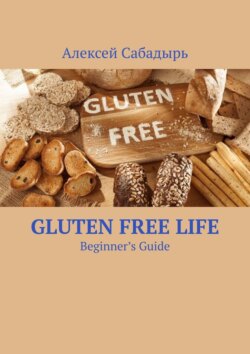Читать книгу Gluten Free Life. Beginner’s Guide - Алексей Сабадырь - Страница 2
ОглавлениеChapter 1: Understanding Gluten and Its Impact on Health
Introduction to Gluten: Study of the nature and origin of gluten, analysis of its presence in various foods and its role in the food industry.
What is celiac disease?: Understanding the autoimmune condition caused by gluten consumption, its symptoms, diagnosis and prevalence.
Gluten Sensitivity: Expanding the concept of gluten sensitivity, its symptoms, and the growing recognition of the condition.
Gluten and the body
Effects on Digestion: A detailed description of how gluten interacts with the digestive system, including its effect on the intestinal lining and the development of inflammation.
Beyond Digestion: Exploring the potential systemic effects of gluten, ranging from skin problems to neurological consequences.
The Science and Impact of Gluten
Gluten and Autoimmunity: A dive into the mechanisms by which gluten can trigger autoimmune reactions, including molecular mimicry and immune system activation.
Area of Research: Covers the latest scientific research and findings regarding gluten-related health issues.
Sources of Hidden Gluten: Identifying unexpected sources of gluten in foods, cosmetics, medications and everyday items.
Reading Labels: A guide to deciphering food labels and recognizing gluten-related terminology so you can make informed food choices
The Rise of Gluten Awareness: Tracing the evolution of gluten awareness in modern society, from dietary trends to increasing incidence of gluten-related illnesses.
The Gluten-Free Movement: Exploring the rise of gluten-free foods, lifestyle changes, and the influence of media and health trends.
Wrap-up: Recap key ideas and set the stage for exploring gluten-free living in subsequent chapters.
The purpose of this comprehensive chapter is to educate readers about the complexities surrounding gluten, its health effects, and the basics of adopting a gluten-free lifestyle.
Chapter 2: Transition to Transition: Your Journey to a Gluten-Free Lifestyle.
Assessing your readiness: Reflect on your personal motivations and reasons for adopting a gluten-free lifestyle.
Kitchen Makeover: Tips to declutter your pantry, understand hidden sources of gluten, and stock up on gluten-free pantry essentials.
Education and Empowerment: Understanding food labels, recognizing gluten-containing ingredients, and finding safe alternatives.
Building a support system: Build a support network, find online communities, and seek advice from health professionals or nutritionists.
Navigating Social Settings: Strategies for managing social events, dining out, and communicating the dietary needs of friends, family, and restaurants.
Managing cravings and withdrawal: Mechanisms for coping with cravings and adapting to changes in diet and taste preferences.
Meal Planning and Prep: Step-by-step instructions for planning gluten-free meals, tips for grocery shopping, and preparing portions for convenience.
Gluten-Free Travel: Tips for maintaining a gluten-free lifestyle while traveling, including researching, socializing, and packing essentials.
Emotional and mental well-being
Emotional Resilience: Addressing the emotional aspects of transitioning to a new lifestyle, dealing with disappointment, and celebrating small victories.
Mindful Eating Practice: Encouraging the development of mindful eating habits, interactions with food, and presence while eating.
Journal of your journey: Keep a food journal, track your progress, and notice changes in your health, energy levels, and overall well-being.
Making adjustments: Understanding that transition takes time and adjusting plans and approaches based on personal experience and feedback.
Celebrating Milestones: Reflecting on accomplishments and setting realistic expectations for the ongoing journey toward a sustainable gluten-free lifestyle.
This chapter offers a practical roadmap for readers embarking on a gluten-free lifestyle, addressing challenges, providing guidance, and promoting a positive mindset for a successful transition and long-term commitment.
Chapter 3: Benefits of Going Gluten Free: Energy Release and Feeling Good
This chapter is an exploration of the potential benefits of switching to a gluten-free diet, particularly in terms of how it can affect energy levels and overall well-being. Firstly, we could dive into what gluten actually is and its role in our diet. Gluten, a protein found in wheat, barley and rye, is known to cause problems in people with celiac disease, gluten sensitivity or wheat allergies. A detailed description of these conditions and how they manifest can help readers determine whether they will benefit from a gluten-free lifestyle.
Next, we could discuss the potential benefits of going gluten-free. Many proponents claim that increased energy levels, reduced digestive discomfort, and improved overall well-being are key benefits. Including personal stories or case studies of people who experienced these improvements could add an interesting touch.
Learning about alternative grains and food options that do not contain gluten, such as quinoa, rice, corn and buckwheat, can be valuable information for those transitioning to this diet. Additionally, it is critical to address the importance of maintaining a balanced diet when going gluten-free to ensure adequate nutrient intake.
It may also be helpful to share tips on how to navigate social situations, dining out, and grocery shopping while following a gluten-free diet. Additionally, it would be a responsible step to emphasize the importance of consulting with a medical professional or nutritionist before making significant dietary changes for personalized guidance.
Chapter 4 Gluten Free and Nutrient Rich: Creating a Balanced Diet
Establishing a balanced, nutrient-rich gluten-free diet is essential to maintaining optimal health while avoiding foods containing gluten. Here’s a breakdown of how to ensure you’re getting all the nutrients you need:
1. Choose natural, gluten-free products. Focus on whole, unprocessed foods that are naturally gluten-free. This includes fruits, vegetables, lean meats, fish, poultry, eggs, legumes, nuts, seeds and dairy products (as tolerated). They form the basis of a nutrient-rich diet.
